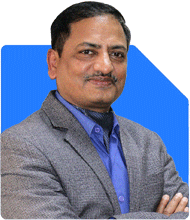15-Year Investment Plan: How to Allocate ₹5 Lakhs and a Monthly SIP of ₹20,000?
Ramalingam Kalirajan |10872 Answers |Ask -Follow
Mutual Funds, Financial Planning Expert - Answered on Apr 11, 2025
He has an MBA in finance from the University of Madras and is a certified financial planner.
He is the director and chief financial planner at Holistic Investment, a Chennai-based firm that offers financial planning and wealth management advice.... more

Hii Sir Please can u tell me the best MF portfolio allocation Goal - 1cr time 15 yr Goal 50 pac time 10 yr I have emeri fund all sat, just need the fund portfolio , if u can tell me fund name it will help, if not then only fund type. For lumpsum of 5 lac And monthly sip of 20K
You are working with a clear vision. That makes wealth-building easier.
Now, let us design a long-term mutual fund allocation strategy.
We will align this plan to your two important goals:
Rs 1 crore in 15 years
Rs 50 lakh in 10 years
Let us structure this with both lumpsum and SIP allocation.
Understanding Your Time Horizons and Risk Appetite
You have two different time frames: 15 years and 10 years
These allow long-term compounding and exposure to equity
Based on your goal, your risk appetite can be assumed as moderately high
Equity exposure will help beat inflation and build real wealth
Debt allocation will protect from market downsides and balance volatility
Diversification will be the key driver for long-term growth
Choosing the right mix matters more than chasing highest returns
A Certified Financial Planner (CFP) helps structure these choices wisely
Now let’s get into the ideal structure.
Lumpsum Rs 5 Lakh – Suggested Portfolio Allocation
This is your one-time capital. Should be invested wisely and spread properly.
Large & Mid Cap Fund – Rs 1.5 lakh
Balanced exposure. Good for long-term.
Flexi Cap Fund – Rs 1 lakh
Fund manager can switch allocation freely. Good for changing markets.
Mid Cap Fund – Rs 75,000
Can offer good growth. Slightly higher risk. Suitable for 10-15 year horizon.
Small Cap Fund – Rs 50,000
Higher risk. Volatile. But long-term returns can be strong.
Contra or Value Fund – Rs 75,000
Contrarian approach. Useful for diversification.
Hybrid Aggressive Fund – Rs 50,000
Mix of debt and equity. Offers some cushion to your portfolio.
Total = Rs 5 lakh diversified across six categories.
Monthly SIP of Rs 20,000 – Suggested Portfolio
Now we allocate your monthly investments to support both goals.
Large Cap Fund – Rs 3,000
Stable. Good for consistent long-term growth.
Large & Mid Cap Fund – Rs 3,000
Combines stability with growth potential.
Flexi Cap Fund – Rs 3,000
Dynamic asset allocation. Fund manager has flexibility.
Mid Cap Fund – Rs 3,000
Suitable for your 15-year goal. Medium risk.
Small Cap Fund – Rs 2,000
Risky, but can outperform in long term. Good for 15 years, not 10.
Focused Fund – Rs 2,000
Invests in limited stocks. Potential for high return. But also higher risk.
Hybrid Equity Fund – Rs 2,000
Mix of equity and debt. Provides cushion. Supports short- to mid-term goal.
Total SIP = Rs 20,000 per month across seven fund categories.
Fund Category Selection Logic
You will notice we selected both aggressive and stable fund types.
Large cap and hybrid funds bring stability.
Small and mid caps support long-term growth.
Flexi cap and focused funds give room for fund manager strategy.
Overall blend reduces risk and improves return potential.
There is no overlap between categories. This avoids redundancy.
Every rupee is working differently for you.
That's how compounding gets its power.
Avoid chasing only past returns.
Focus on fund strategy and consistency.
Your mix must be actively reviewed every year.
Why You Should Avoid Index Funds
Index funds blindly follow the market. No active decisions.
Poor during market correction or sideways movement.
Underperform during volatility.
No downside protection strategy.
No scope for fund manager to avoid bad sectors.
You lose out during crisis years.
Actively managed funds offer better long-term outcomes.
Especially when handled by Certified Financial Planner with research support.
Why You Should Not Use Direct Funds
Direct funds are bought without expert guidance.
You miss personalised advice and monitoring.
No behavioural coaching when markets fall.
DIY investing sounds good. But discipline and planning are missed.
Regular plans through a trusted CFP-supported MFD offer better value.
You get goal tracking, annual review, and portfolio rebalancing.
Cost difference is small. But impact of advice is large.
Regular plans help avoid emotional mistakes.
Investing without guidance can derail your wealth journey.
Monitoring and Review Strategy
Your SIPs must be reviewed once a year.
Watch underperformance for more than 2 years.
Don’t stop SIPs in market fall. That is when you accumulate more units.
Use a portfolio tracker or let your CFP monitor it.
Maintain asset allocation ratio.
If one category outperforms, rebalance to keep mix right.
Don't get influenced by friends or social media funds.
Stick to your personal goals. Not someone else's advice.
Goal-wise Mapping Strategy
Let’s break your portfolio as per your goals.
Goal 1: Rs 1 crore in 15 years
Use 70% of your investments for this goal
All high-risk and long-term funds go here
Small cap, mid cap, flexi cap will support this goal
Keep investing even if markets go down
Let compounding work without interruptions
Goal 2: Rs 50 lakh in 10 years
Use 30% of your SIP for this goal
Slightly reduce small cap and mid cap
Add more hybrid and large cap to bring stability
Review after 7 years. Start moving to safer funds by year 8
Create a withdrawal strategy for goal maturity
Use SWP or staggered withdrawal to avoid tax burden
Taxation on Mutual Funds (Updated Rules)
Long Term Capital Gain on Equity MF taxed at 12.5% above Rs 1.25 lakh yearly
Short Term Capital Gain on Equity MF taxed at 20%
Debt MF gains taxed as per your income slab
SIPs also follow same tax rule based on each instalment date
Plan redemptions to reduce tax impact
A Certified Financial Planner can help you with this planning
Other Pointers for 360 Degree Financial Plan
Make sure your emergency fund remains untouched
Get a term insurance equal to 15x your annual income
Get Rs 25-30 lakh family floater health insurance
Don’t mix insurance and investment like ULIPs
Avoid child insurance plans and unit linked plans
Continue SIPs during market correction. That builds real wealth
Keep your risk appetite in mind when reviewing your portfolio
Use a goal tracker and invest with discipline
Celebrate small milestones every year
Wealth creation is a long-term journey
Make decisions slowly but stick with them
Don’t chase hot funds or new trends
SIP is not magic. Patience is magic
Finally
Your Rs 5 lakh lump sum and Rs 20K SIP can achieve both your goals.
You are already on the right path by planning early.
Selecting the right fund types will boost your outcome.
Avoid direct funds and index funds.
Get a Certified Financial Planner to track and adjust your journey.
Wealth creation is not one-time. It is a continuous effort.
Give your money the time to grow.
Stay consistent. Stay long term.
Every month brings you closer to your dream.
Let your investments work hard, so you can rest easy.
Best Regards,
K. Ramalingam, MBA, CFP,
Chief Financial Planner,
www.holisticinvestment.in
https://www.youtube.com/@HolisticInvestment
You may like to see similar questions and answers below
Sanjeev Govila | Answer |Ask -Follow
Financial Planner - Answered on Feb 06, 2024
Ramalingam Kalirajan |10872 Answers |Ask -Follow
Mutual Funds, Financial Planning Expert - Answered on May 15, 2024
Ramalingam Kalirajan |10872 Answers |Ask -Follow
Mutual Funds, Financial Planning Expert - Answered on Nov 18, 2024
Ramalingam Kalirajan |10872 Answers |Ask -Follow
Mutual Funds, Financial Planning Expert - Answered on Jan 20, 2025
Ramalingam Kalirajan |10872 Answers |Ask -Follow
Mutual Funds, Financial Planning Expert - Answered on Jan 30, 2025
Nayagam P P |10852 Answers |Ask -Follow
Career Counsellor - Answered on Dec 07, 2025

Research Career Prospects: IISc, IITs, and Beyond: For research-oriented careers, the Integrated M.Sc Physics program at Amrita provides an exceptional foundation. Amrita's curriculum specifically aligns with GATE and UGC-NET examination syllabi, and the institution emphasizes early research engagement. The faculty at Amrita actively publish research in Scopus-indexed journals, with over 60 publications in international venues within the past five years, exposing you to active research environments.
To pursue research at premier institutions like IISc, you would typically follow the PhD pathway. IISc accepts M.Sc graduates through their Integrated PhD programs, and with your Amrita M.Sc, you're eligible to apply. You'll need to qualify the relevant entrance examinations, and your integrated program's emphasis on research fundamentals provides strong preparation. The final year of your Integrated M.Sc is intentionally structured to be nearly free of classroom commitments, enabling engagement with research projects at institutes like IISc, IITs, and National Labs. According to Amrita's data, over 80% of M.Sc Physics students secured internship offers from reputed institutions during academic year 2019-20, directly facilitating research career transitions.
Placement and Direct Employment Opportunities: Amrita University boasts a comprehensive placement ecosystem with strong corporate and government sector connections. According to NIRF placement data for the Amrita Integrated M.Sc program (5-year), the median salary in 2023-24 stood at ?7.2 LPA with approximately 57% placement rate. However, these figures reflect general placement trends; physics graduates often secure higher packages in specialized technical roles. Many graduates join software companies like Infosys (with early offers), Google, and PayPal, where their strong analytical and computational skills command competitive compensation packages ranging from ?8-15 LPA for entry-level positions.
The Department of Corporate and Industrial Relations at Amrita provides intensive three-semester life skills training covering linguistic competence, data interpretation, group discussions, and interview techniques. This structured placement support significantly enhances your employability in both government and private sectors.
Government Sector Opportunities: UPSC, BARC, DRDO, and ISRO: Your M.Sc Physics degree opens multiple avenues for prestigious government employment. UPSC Geophysicist examinations explicitly list M.Sc Physics or Applied Physics as qualifying degrees, enabling you to compete for Group A positions in the Geological Survey of India and Central Ground Water Board. The age limit for geophysicist positions is 32 years (with relaxation for reserved categories), and the exam comprises preliminary, main, and interview stages.
BARC (Bhabha Atomic Research Centre) actively recruits M.Sc Physics graduates as Scientific Officers and Research Fellows. Recruitment occurs through the BARC Online Test or GATE scores, with positions in nuclear science, radiation protection, and atomic research. BARC Summer Internship programs are available, offering ?5,000-?10,000 monthly stipends with opportunity for future scientist recruitment.
DRDO (Defense Research and Development Organization) recruits M.Sc Physics graduates through CEPTAM examinations or GATE scores for roles involving defense technology, weapon systems, and laser physics research. ISRO (Indian Space Research Organisation) regularly advertises scientist/engineer positions through competitive recruitment for candidates with strong physics backgrounds, offering opportunities in satellite technology and space science applications.
Other significant employers include the Indian Meteorological Department (IMD) recruiting as scientific officers, and NPCIL (Nuclear Power Corporation of India Limited), offering stable government service with competitive compensation packages exceeding ?8-12 LPA for scientists.
Alternate Career Pathways: UPSC, CDS, and AFCAT: UPSC Civil Services (IFS - Indian Forest Service): M.Sc Physics graduates qualify for UPSC Civil Services examinations, with the forest service offering opportunities for science-based administrative roles with potential to reach senior government positions.
CDS/AFCAT (Armed Forces): While AFCAT meteorology branches specifically require "B.Sc with Maths & Physics with 60% minimum marks," the technical branches (Aeronautical Engineering and Ground Duty Technical roles) require graduation/integrated postgraduation in Engineering/Technology. An M.Sc Physics integrates well with technical qualifications, though you would need engineering background for direct officer entry. However, you remain eligible for specialized technical interviews if applying through alternate defence channels.
UGC-NET Examination: This pathway leads to Assistant Professor positions in central universities and colleges across India. NET-qualified candidates receive scholarships of ?31,000/month for 2-year JRF positions with PhD pursuit, transitioning to Assistant Professor salaries of ?41,000/month in government institutions. This route provides long-term academic career security with research opportunities.
Private Sector Technical Roles
M.Sc Physics graduates are increasingly valued in data science, software engineering, and technical consulting. Companies actively recruit physics graduates for software development, where strong problem-solving and logical reasoning translate to competitive packages of ?10-20 LPA. Specialized domains including quantum computing development, financial modeling, and scientific computing offer premium compensation. Your minor in Scientific Computing makes you particularly attractive to technology companies requiring computational expertise.
International Opportunities and Higher Studies Abroad
An M.Sc from Amrita facilitates admission to PhD programs at international institutions. German universities offer tuition-free or low-fee MSc Physics programs (2 years) with scholarships like DAAD providing €850+ monthly stipends. US universities accept M.Sc graduates directly for PhD positions with full funding (tuition coverage + stipend). These pathways require GRE scores and strong Statement of Purpose articulating research interests. Research collaboration opportunities exist with Max Planck Institute (Germany) and CalTech Summer Research Program (USA), both welcoming Indian M.Sc students.
Essential Skills and Certifications to Develop Immediately: Programming Languages: Start learning Python immediately—it's universally used in research and industry. Dedicate 2-3 hours weekly to data analysis, scientific computing libraries (NumPy, SciPy, Pandas), and machine learning fundamentals. MATLAB is equally critical for physics applications, particularly numerical simulations and data visualization. Aim to complete MATLAB certification courses within your first year.
Research Tools: Learn Git/version control, LaTeX for scientific documentation, and data analysis frameworks. These skills are indispensable for publishing research papers and collaborating on projects.
Certifications Worth Pursuing: (1) MATLAB Certification (DIYguru or MathWorks official courses) (2) Python for Data Science (complete certificate programs from platforms like Coursera) (3) Machine Learning Fundamentals (for expanding technical versatility) & (4) Scientific Communication and Technical Writing (develop through departmental workshops)
Strategic Internship Planning: Leverage Amrita's research connections systematically. In your third year, apply to BARC Summer Internship, IISER Internships, TIFR Summer Fellowships, and IIT Internship programs (like IIT Kanpur SURGE). These expose you to frontier research while establishing connections for future PhD or scientist recruitment. Target 2-3 research internships across different specializations to develop versatility.
TO SUM UP, Your Integrated M.Sc Physics degree from Amrita positions you exceptionally well for competitive research careers at IISc/IITs, prestigious government scientist roles at BARC/DRDO/ISRO, and international PhD opportunities. The program's scientific computing emphasis differentiates you in the job market. Immediate priorities: (1) Master Python and MATLAB within the first two years; (2) Engage in research projects starting year 2-3; (3) Target internships at premiere research institutions; (4) Prepare GATE while completing your degree for maximum flexibility in recruitment; (5) Consider UGC-NET for long-term academic stability. Your career trajectory will ultimately depend on developing strong research fundamentals, demonstrating consistent excellence in specialization areas, and strategically selecting internship and research opportunities. The rigorous Amrita program combined with disciplined skill development positions you for exceptional career success across multiple sectors. Choose the most suitable option for you out of the various options available mentioned above. All the BEST for Your Prosperous Future!
Follow RediffGURUS to Know More on 'Careers | Money | Health | Relationships'.
Nayagam P P |10852 Answers |Ask -Follow
Career Counsellor - Answered on Dec 07, 2025
Radheshyam Zanwar |6736 Answers |Ask -Follow
MHT-CET, IIT-JEE, NEET-UG Expert - Answered on Dec 06, 2025

Good luck.
Follow me if you receive this reply.
Radheshyam
Dr Nagarajan J S K |2576 Answers |Ask -Follow
NEET, Medical, Pharmacy Careers - Answered on Dec 06, 2025
Mihir Tanna |1090 Answers |Ask -Follow
Tax Expert - Answered on Dec 06, 2025
Ramalingam Kalirajan |10872 Answers |Ask -Follow
Mutual Funds, Financial Planning Expert - Answered on Dec 06, 2025
Radheshyam Zanwar |6736 Answers |Ask -Follow
MHT-CET, IIT-JEE, NEET-UG Expert - Answered on Dec 06, 2025
Radheshyam Zanwar |6736 Answers |Ask -Follow
MHT-CET, IIT-JEE, NEET-UG Expert - Answered on Dec 06, 2025
Radheshyam Zanwar |6736 Answers |Ask -Follow
MHT-CET, IIT-JEE, NEET-UG Expert - Answered on Dec 06, 2025
Dr Dipankar Dutta |1837 Answers |Ask -Follow
Tech Careers and Skill Development Expert - Answered on Dec 05, 2025























